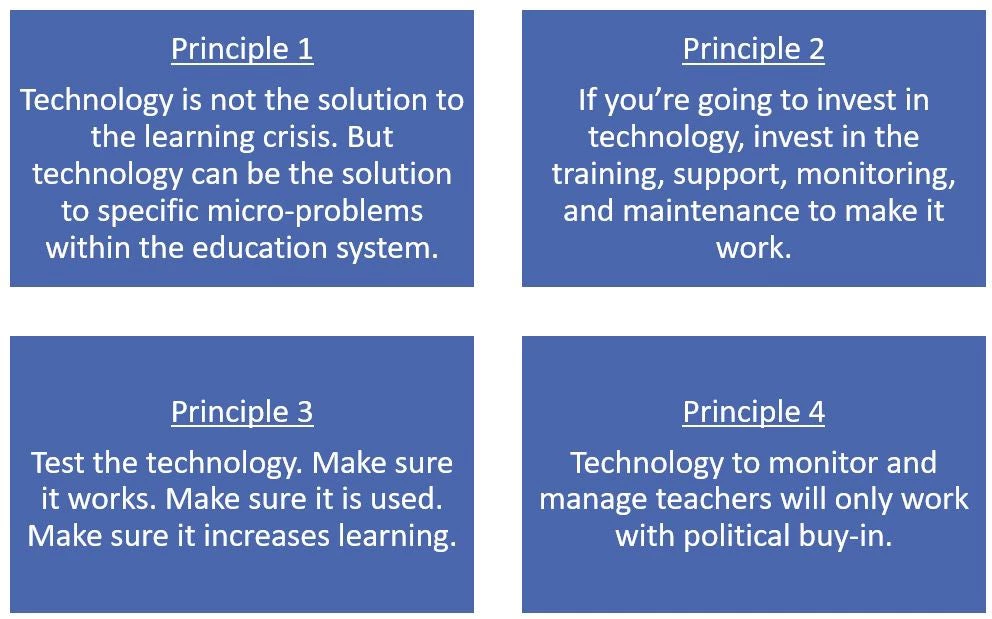 Teacher with students
Teacher with students
Teachers matter enormously to student learning. Teachers deliver academic knowledge. Teachers impart model socioemotional skills. Good teachers boost students’ long-term life outcomes. Teachers can inspire (and in another demonstration of their importance, in some cases, sadly, teachers can disappoint or even abuse).
Yet teachers, often lionized and occasionally villainized, are people. They enter the profession for a wide range of reasons, they have their own families to feed, and – like most professionals – they respond to incentives, support, accountability, and the quality of the management around them. In short, they are part of a system.
Getting teacher policies right isn’t always easy, and sometimes education technology solutions can seem like a shortcut. It’s tempting to search for the perfect app that will “disrupt” the learning process and allow countries to “leapfrog” to high-quality, equitable education without having to engage with these complicated people near the center of the learning process. (Let’s keep learners at the actual center.) Education technology interventions have had both successes and failures. Even as the COVID crisis has heightened attention to education technology, many parts of the world lack the infrastructure for it have an extended, effective reach, with big implications for educational inequality.
In a recent note—“Education Technology for Effective Teachers”—I look for examples of how education technology—rather than seeking to circumvent teachers—can help teachers to be as effective as possible and make their jobs and lives easier in the process. Looking at a wide range of experiences, mostly in low- and middle-income countries, I identify and discuss four principles to guide investments in technology to boost teacher effectiveness.
Beyond these principles, which may seem obvious but which anyone who has worked in the implementation or evaluation of education technology can tell you are often not applied, I provide practical examples of six ways that education systems are using technology to support teachers. I summarize these in the table below, but you can find more country experiences in the note.
| Systems can use technology to… | Where and how |
| Coach and mentor teachers |
|
| Complement teacher content knowledge and pedagogical skills |
|
| Create virtual communities of practice for teachers |
|
| Manage teachers effectively |
|
| Deploy the teacher workforce effectively |
|
| Increase the attractiveness of the teaching profession |
|
Technology is not the solution, but just like books and classrooms and blackboards, technological tools can help teachers to improve their skills, to use their skills most effectively, and to be accountable. These investments should never be made on the basis of evidence-free optimism but rather evidence-based realism in terms of systems’ capacity to maintain the technology, teacher willingness to engage the technology, and whether the technology will perform better than the cheaper, analog alternative.
(In Kenya, a tablet-based literacy program boosted learning, but no more so than the analog alternative and at higher cost.)
But in cases where technology passes those tests, it can be a valuable complement to teachers. It can also make teachers’ jobs a little bit easier so they can focus their energy on teaching.
Further reading:
- For more on how this brief fits within the World Bank’s program for teachers, check out Saavedra’s blog post from earlier this month, “Realizing the promise of effective teachers for every child – a global platform for successful teachers”
- For more on how to foster effective teachers, check out Béteille’s and my approach paper “Successful Teachers, Successful Students: Recruiting and Supporting Society’s Most Crucial Profession” or the World Development Report 2018 chapter on teachers.
- For a broader framework on how to apply education technology in systems (beyond its interactions with teachers), check out Ganimian, Vegas, and Hess’s 2020 report “Realizing the Promise: How Can Education Technology Improve Learning for All?”



Join the Conversation